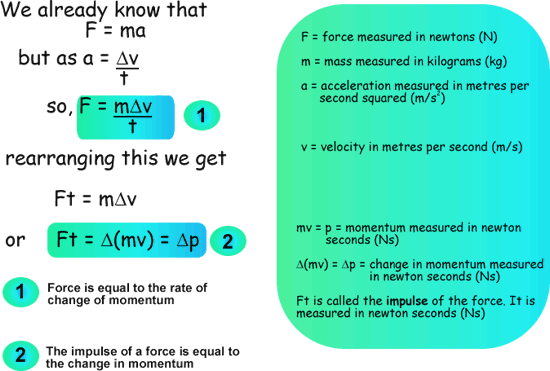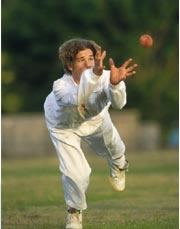    |
||||

Momentum |
||||
|
Momentum has two parts to it. The velocity 'v' of the object and also the mass 'm' of the object. Velocity is a vector so momentum is a vector. Velocity is speed in a particular direction. Momentum has direction associated with it too. If two bodies were moving in opposite directions their momentum would have opposite signs, just as their velocities would have opposite signs. This becomes very important when two or more bodies hit each other. Click here for information of the conservation of momentum.
Application of momentum to everyday situations
Your sports coach will have taught you to extend the time you spend making the ball stop. By increasing 't' the 'F' is smaller and your hand stings less. So by reaching out for the ball and then pulling it towards you as you catch it you risk hurting yourself less than if you stop it 'dead'.
You need to think about that force in terms of pressure too. If you wear a glove to catch a ball the contact area with that ball is greater when you catch it. You therefore experience less pressure from the force when you stop it. This makes damage to your hand less likely - as it is pressure from a force that causes the potential damage.
|
||||
 |
||||


 If you are used to catching balls you know that catching a fast light ball can hurt your hands as much as catching a slow heavy one. It can make your hands sting... this is because your hand has to supply the force to change the momentum of the ball to zero (a stopped ball has a momentum of zero as its velocity will be zero and momentum is the product of mass and velocity).
If you are used to catching balls you know that catching a fast light ball can hurt your hands as much as catching a slow heavy one. It can make your hands sting... this is because your hand has to supply the force to change the momentum of the ball to zero (a stopped ball has a momentum of zero as its velocity will be zero and momentum is the product of mass and velocity). You need the same impulse to bring the ball to a standstill - you just choose to have a longer 't' and smaller 'F' and that makes the catching experience more comfortable.
You need the same impulse to bring the ball to a standstill - you just choose to have a longer 't' and smaller 'F' and that makes the catching experience more comfortable.

